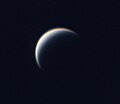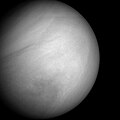
There have been 46 space missions to the planet Venus (including gravity-assist flybys). Missions to Venus constitute part of the exploration of Venus. The Soviet Union, followed by the United States, have soft landed probes on the surface. Venera 7 was the first lander overall and first for the Soviet Union, touching down on 15 December 1970. Pioneer Venus 2 contained the first spacecraft to land from the United States, the Day Probe. It soft landed on 9 December 1978. [1] [2] [3] [4] [5] [6] The most recent lander was part of the Vega 2 mission, which soft landed on 15 June 1985.


